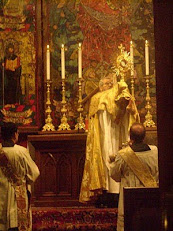The version given in the BDW is below.
O Gracious Light Phos hilaron
O gracious Light,
pure brightness of the everliving Father in heaven,
O Jesus Christ, holy and blessed!
Now as we come to the setting of the sun,
and our eyes behold the vesper light,
we sing thy praises, O God: Father, Son, and Holy Spirit.
Thou art worthy at all times to be praised by happy voices,
O Son of God, O Giver of life,
and to be glorified through all the worlds.
Unfortunately, of course, there is no music in the BDW, nor a reference to where the music for this translation of the hymn can be found. In chanting the office, I usually fell back on using the version found in the Liturgy of the Hours, sung to the tune "Jesu, dulcis memoria" (LM). But a few years ago I stumbled upon the web site of the Metropolitan Cantor's Institute of the Byzantine Catholic Eparchy of Pittsburgh (and doesn't it say something that there is a Cantor's Institute in an Eastern eparchy, i.e., diocese; you'd be hardpressed to find the equivalent in a Latin diocese). And there I found the archive of sheet music. The version of the Phos Hilaron below is from that archive.
This version pairs well with the chants from St. Dunstan's Plainsong Psalter for chanted Evensong, I find. Here's hoping that the Ordinariate will also find its way to establish some equivalent to a Cantors (a Schola) Institute, for the preservation, teaching and handing on of the Anglican musical patrimony: its hymnody, the chant work of learned clergy such as Canon Douglas, and Anglican Chant.















While I love the Phos Hilaron very much, I don't really see how it is part of the Anglican (or, come to think of it, Latin Rite) patrimony. During the liturgical reform, many elements of our own, western patrimony were cast out in favour of Byzantine elements. The result very often is a hybrid rite, not really Latin but not really Byzantine either.
ReplyDeleteOn the contrary, borrowing from the Eastern rites is a long established tradition in Anglicanism (think of "A Prayer of St Chrysostom"), and it renew the communication that existed between Eastern and Western rites for the whole 1st millennium. Furthermore, this is a beautiful English translation of this Greek hymn, and since Neale, such translations are very much part of our patrimony.
Delete+ PAX et BONUM
This comment has been removed by the author.
Delete"Let All Mortal Flesh Keep Silence" is another example of something beautiful and very Anglican that was borrowed from the Eastern rites.
DeleteI happen to think that the BCP/BDW translation of the Phos Hilaron is pretty wretched. That said, if one wants to use it, I think there are chants in the 1982 Hymnal or in some of the 70s-80s era loof-leaf publications from the Church Pension Fund/Hymnal Society. The one virtue it has is that it is a default "placeholder" for any other office hymn or, if one likes the Phos Hilaron, a better translation of the same.
ReplyDeleteIt was used as a canticle for Evensong in the Third Series revision (late 70s) in the CofE
ReplyDeleteThe version/translation was from Hymns A&M Revised 1950
A rendering is here
http://www.youtube.com/watch?v=lnme7rvprYs
Not sure how long this 'Series 3' services lasted, probably until 1980 ASBeen book; does that count as 'patrimony'?!